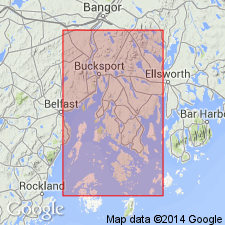
- Usage in publication:
-
- Seven Hundred Acre Island Formation*
- Modifications:
-
- Named
- Dominant lithology:
-
- Quartzite
- Marble
- Schist
- Amphibolite
- Gneiss
- AAPG geologic province:
-
- New England province
Summary:
Named for Seven Hundred Island in northern Penobscot Bay. Includes some rocks previously called Coombs Limestone Member of Islesboro Formation by Smith and others (1907). Type locality is southern shoreline of Cradle Cove on Seven Hundred Acre Island. Also outcrops in Islesboro on western side of Gilkey Harbor and are exposed on its northern side at low tide. Excellent outcrops also occur along shores of Spruce Island, all of Lime Island, Northern part of Lasell Island, and east shore of Seal Harbor; a small (5 by 10 m) outcrop is exposed only at low tide on west side of Turtle Head and is too small to be shown at map scale. Consists of thin- to thick-bedded quartzite, siliceous dolomitic marble, splendent muscovite-garnet-staurolite-andalusite schist, hornblende-garnet amphibolite, feldspathic biotite or phlogopite gneiss, and graphitic metapelite in lithologic packages 2 to 15 m thick. Metabasalt occurs as dikes and sills throughout section. Thickness is at least 200 m; base not exposed. Age is Late Proterozoic based on estimate from Rb-Sr whole rock age of 750+/-100 Ma (Brookins, 1976).
Source: GNU records (USGS DDS-6; Reston GNULEX).
For more information, please contact Nancy Stamm, Geologic Names Committee Secretary.
Asterisk (*) indicates published by U.S. Geological Survey authors.
"No current usage" (†) implies that a name has been abandoned or has fallen into disuse. Former usage and, if known, replacement name given in parentheses ( ).
Slash (/) indicates name conflicts with nomenclatural guidelines (CSN, 1933; ACSN, 1961, 1970; NACSN, 1983, 2005, 2021). May be explained within brackets ([ ]).

